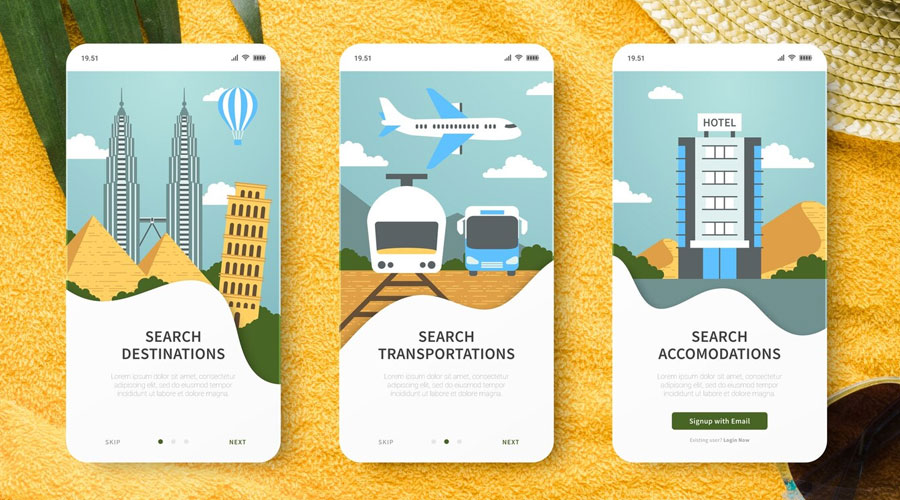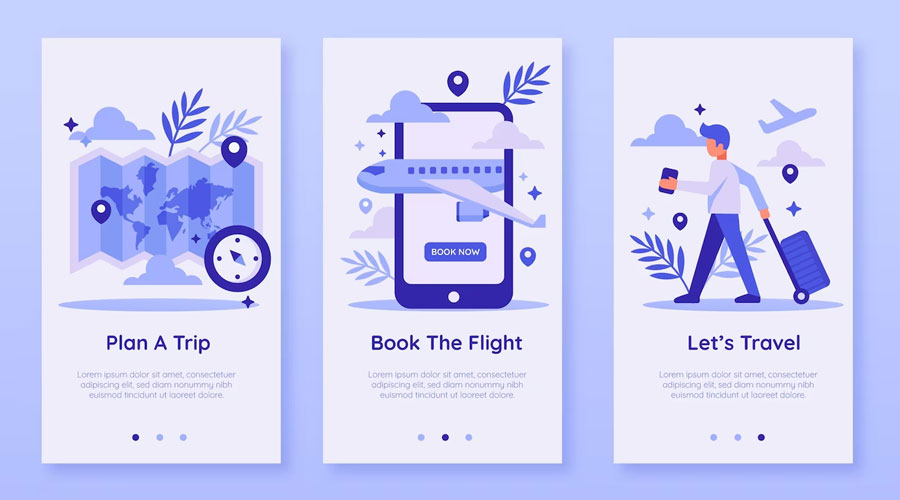Table of Contents
Role of Travel and Tourism Apps
let’s delve further into the role of travel and tourism apps, exploring additional aspects that highlight their significance in the industry:
- Accessibility and Inclusivity: Travel apps have made travel more accessible to a broader range of people, including those with disabilities. Developers work to ensure that their apps are compatible with assistive technologies and provide features like voice-guided navigation and text-to-speech functions. This makes it easier for travelers with visual or hearing impairments to explore the world.
- Paperless Travel: Travel app developers have significantly contributed to reducing the environmental impact of travel by making it possible to go paperless. E-tickets, electronic boarding passes, and digital travel itineraries have replaced the need for physical documents, reducing paper waste and streamlining the travel experience.
- Crisis Management: Travel apps often incorporate features that help travelers deal with unexpected crises, such as natural disasters, political unrest, or health emergencies. These apps provide information on evacuation routes, safe havens, and contact details for local authorities or embassies.
- Multimodal Transportation: Many travel apps integrate various modes of transportation, allowing travelers to seamlessly combine flights, trains, buses, and rideshares to create the most efficient and cost-effective routes. This simplifies complex travel itineraries.
- Economic Impact: Travel and tourism apps have a significant economic impact on local and global scales. They create job opportunities, stimulate demand for travel-related services, and drive revenue for airlines, hotels, and other businesses in the tourism sector.
- Data Analytics and Market Insights: Travel app developers leverage data analytics to gain insights into user behavior, preferences, and market trends. This information helps them improve their apps, tailor offers, and provide more relevant content to users.
- Business Travel: Travel apps cater to business travelers by offering features such as expense tracking, travel policy compliance, and seamless integration with corporate booking systems. This streamlines the business travel experience and ensures companies can manage their employees’ travel expenses effectively.
- Innovative Marketing: Travel and tourism app developers are constantly exploring innovative marketing strategies, such as location-based promotions and partnerships with influencers. These efforts help boost app visibility, attract new users, and retain loyal customers.
- Cultural Preservation: Some travel apps collaborate with cultural organizations and heritage sites to promote responsible and sustainable tourism. By encouraging travelers to respect local customs and protect historical sites, these apps contribute to cultural preservation efforts.
- Feedback Loops: Travel apps often include feedback mechanisms, allowing users to rate and review services. Developers use this feedback to improve the quality of their offerings and address any issues that users may encounter.
- Integration with Wearable Technology: As wearable technology becomes more prevalent, travel apps are exploring integration with devices like smartwatches and augmented reality glasses. This allows travelers to access information and navigate their surroundings without the need to pull out their smartphones.
- Weather and Health Alerts: Travel app developers provide real-time weather updates and health alerts, helping travelers make informed decisions about their journeys. This is especially important in regions prone to extreme weather conditions or health risks.
Key Features and Functionality
let’s delve deeper into some key features and functionalities that travel and tourism app developers can incorporate to enhance the user experience and make their apps stand out in a competitive market:
- Smart Recommendations: Travel apps can use AI and machine learning to provide personalized recommendations for accommodations, activities, and dining based on the user’s preferences, past bookings, and behavior within the app. This not only improves the user experience but also encourages users to explore new options.
- Integrated Travel Insurance: Offering users the option to purchase travel insurance directly through the app can be a valuable addition. This provides peace of mind for travelers and ensures they are protected in case of cancellations, medical emergencies, or other unforeseen events.
- Weather and Climate Information: Real-time weather updates for the user’s destination can help travelers pack appropriately and plan their activities accordingly. Including climate data and forecasts can enhance the user’s overall experience.
- Cultural Insights: To enrich the travel experience, developers can integrate cultural insights and etiquette tips. This can help travelers understand local customs, traditions, and appropriate behavior in different destinations.
- Language Translation: Offering a built-in language translation feature can be a lifesaver for travelers in foreign countries. This can facilitate communication with locals and enhance the overall experience.
- Offline Maps with Points of Interest: Enhancing offline functionality by providing offline maps with key points of interest, local attractions, and recommended routes allows travelers to explore even without an internet connection.
- User-Generated Content Filtering: Implementing advanced filters for user-generated content, such as reviews and photos, helps users find the most relevant and reliable information when making decisions about their trips.
- Interactive Travel Journals: Adding a feature that enables users to create digital travel journals can be a fun and memorable way for travelers to document their journeys and share their experiences with friends and family.
- Travel Expense Tracking: Including a feature that allows users to track and manage their travel expenses, including currency conversion and budgeting, can help travelers stay within their financial limits.
- Accessibility Features: Ensuring that the app is accessible to all travelers, including those with disabilities, is an important consideration. Developers can add features like voice navigation and screen reader compatibility to cater to a broader user base.
- Real-Time Chat Support: Offering real-time chat support within the app can help users get quick answers to their questions or resolve any issues that may arise during their travels.
- In-App Purchases and Discounts: Travel apps can partner with local businesses to provide exclusive in-app discounts and offers, encouraging users to book activities or dining experiences directly through the app.
- Trip Sharing: Allowing users to share their itineraries and travel plans with friends and family directly from the app can enhance the social aspect of travel and provide an additional layer of safety.
- Sustainability Ratings: Apps can include sustainability ratings for accommodations, restaurants, and activities, making it easier for users to make environmentally conscious choices while traveling.
- Health and Safety Alerts: In the post-pandemic world, providing users with health and safety alerts and guidelines specific to their travel destination can be crucial for a safe and worry-free journey.
- Feedback and Improvement Suggestions: Encouraging users to provide feedback and improvement suggestions directly within the app helps developers continuously refine and enhance the user experience.
- Travel Document Storage: Offering a secure digital space for users to store and access important travel documents such as passports, visas, and travel insurance policies can be a valuable feature.
Incorporating these features and functionalities can make travel and tourism apps more comprehensive, user-friendly, and appealing to a wide range of travelers. However, it’s essential for developers to strike a balance between innovation and simplicity, ensuring that the app remains easy to navigate and user-centric.
Mobile Platforms and Technologies
In the ever-evolving world of travel and tourism app development, staying up-to-date with the latest mobile platforms and technologies is essential for creating cutting-edge and competitive applications. In this section, we’ll explore some of the key mobile platforms and technologies that travel and tourism app developers are harnessing to provide a seamless and enriched experience for travelers.
1. Mobile Operating Systems (iOS and Android): The majority of travel and tourism apps are developed for two main mobile operating systems: Apple’s iOS and Google’s Android. Developers need to create versions of their apps for both platforms to reach the widest audience. This involves utilizing platform-specific tools and languages, such as Swift for iOS and Java or Kotlin for Android.
2. Cross-Platform Development: To streamline development and reduce costs, many travel app developers are turning to cross-platform development frameworks like React Native, Flutter, or Xamarin. These frameworks allow developers to write code once and deploy it on multiple platforms, thereby reaching a broader user base with less effort.
3. Progressive Web Apps (PWAs): Travel apps are increasingly being developed as PWAs. These are web applications that provide a native app-like experience directly through a web browser. PWAs are known for their offline functionality, quick loading times, and compatibility with various devices and operating systems.
4. Location-Based Services (LBS): Leveraging location-based services is essential for travel apps. Developers use technologies such as GPS, Wi-Fi positioning, and beacon technology to provide real-time location information, navigation, and personalized recommendations.
5. Augmented Reality (AR) and Virtual Reality (VR): AR and VR technologies are finding their way into travel apps, enhancing the user experience. For instance, AR can provide real-time information about landmarks, while VR can offer virtual tours of destinations. Developers use ARKit (iOS) and ARCore (Android) for augmented reality and various VR platforms for virtual reality experiences.
6. Mobile Payment Solutions: In-app payment options have become a standard in travel apps. Developers integrate payment gateways and mobile wallet solutions, such as Apple Pay and Google Pay, to facilitate seamless transactions for flight bookings, accommodations, and other services.
7. Chatbots and AI: Artificial intelligence and chatbots are being used to offer real-time customer support, travel recommendations, and personalized experiences. Machine learning models analyze user behavior and preferences to provide tailored suggestions.
8. Blockchain: Some forward-thinking travel apps are exploring blockchain technology to enhance security and transparency. Blockchain can be used for secure transactions, identity verification, and even for ensuring the authenticity of travel reviews and recommendations.
9. Wearable Devices: The rise of wearable technology, like smartwatches and fitness trackers, presents a new frontier for travel app developers. These devices can display real-time travel information, notifications, and even health-related data to enhance the travel experience.
10. Cloud Computing: Cloud services, such as AWS, Google Cloud, and Azure, are increasingly used for data storage and processing in travel apps. They ensure that user data and preferences can be seamlessly synchronized across different devices.
11. Internet of Things (IoT): IoT devices, like smart luggage with built-in trackers and hotel room automation systems, are integrated with travel apps to provide a connected and smart travel experience.
12. Voice Assistants: Travel apps are embracing voice technology, allowing users to make inquiries, bookings, and receive travel updates using voice commands. Integrating with voice assistants like Siri, Google Assistant, and Amazon Alexa provides convenience for users.
13. 5G Technology: As 5G networks become more widespread, travel apps can leverage this high-speed, low-latency connectivity to provide users with even faster access to information and enhanced multimedia experiences.
14. Security and Privacy: With increasing concerns about data privacy and security, developers are focusing on encryption, biometric authentication, and compliance with data protection regulations (e.g., GDPR) to ensure user trust.
Incorporating these mobile platforms and technologies, travel and tourism app developers are continually enhancing the user experience, making travel more accessible, convenient, and enjoyable for people all around the world. Keeping pace with technological advancements is critical in this fast-evolving industry, ensuring that travel apps remain a valuable and indispensable tool for modern travelers.
Payment Gateways and Security
Payment gateways and security are critical aspects of travel and tourism app development. In this section, we’ll delve into the importance of payment gateways and the security measures travel app developers should implement to protect user data and transactions.
Payment Gateways in Travel Apps
Payment gateways are the digital tools that allow travel and tourism apps to process payments securely. They are essential for any app that involves financial transactions, such as booking flights, accommodations, or activities. Here are some key considerations regarding payment gateways in travel apps:
- Diverse Payment Options: Travel apps should provide a variety of payment options to cater to a global audience. This includes credit and debit cards, mobile wallets, bank transfers, and even cryptocurrency in some cases.
- Integration with Local Payment Methods: To accommodate travelers from different regions, it’s important to integrate with local and regional payment methods, such as Alipay, WeChat Pay, or UPI (Unified Payments Interface) in India.
- Secure Data Transmission: Payment data must be transmitted securely using encryption protocols, typically through HTTPS. This ensures that sensitive information, like credit card numbers, remains confidential during the transaction.
- PCI DSS Compliance: Travel app developers must adhere to the Payment Card Industry Data Security Standard (PCI DSS). This is a set of security standards designed to ensure that all companies that accept, process, store, or transmit credit card information maintain a secure environment.
- Frequent Testing: Payment gateways need to be rigorously tested to ensure they function correctly and securely. This includes tests for credit card processing, refunds, and any other financial transactions supported by the app.
Security in Travel Apps
Ensuring the security of user data and transactions is paramount for travel and tourism apps. Here are some key security measures developers should consider:
- Data Encryption: All data transmitted between the app and the server should be encrypted. This includes personal information, payment details, and any other sensitive data.
- Secure Socket Layer (SSL): Implement SSL certificates to establish secure connections between the user’s device and the server. Users should be able to see the padlock icon in their browser or app to know their data is encrypted.
- User Authentication: Implement strong user authentication methods, such as two-factor authentication (2FA), to prevent unauthorized access to user accounts.
- Regular Security Audits: Conduct regular security audits and penetration testing to identify vulnerabilities and fix them before they can be exploited by malicious actors.
- Firewalls and Intrusion Detection Systems: Use firewalls and intrusion detection systems to monitor and block any unauthorized access attempts to the app’s server.
- Data Backup and Recovery: Regularly back up user data to prevent data loss in the event of a security breach or technical failure.
- Privacy Policy and Data Handling: Clearly outline how user data is collected, stored, and used in the app’s privacy policy. Ensure compliance with data protection regulations, such as GDPR (General Data Protection Regulation) in Europe.
- Regular Updates: Keep the app and its dependencies (e.g., libraries, frameworks, and plugins) up to date to patch known security vulnerabilities.
- User Education: Educate users about best practices for online security, such as creating strong passwords, avoiding public Wi-Fi for sensitive transactions, and recognizing phishing attempts.
- Incident Response Plan: Develop a comprehensive incident response plan to address security breaches promptly and efficiently. This plan should include steps for notifying affected users, authorities, and resolving the issue.
Final Thoughts
Payment gateways and security are critical components of travel and tourism app development. Travel app developers must prioritize these aspects to ensure the safety of user data and financial transactions. By implementing diverse payment options, secure data transmission, and robust security measures, travel app developers can build trust among users and create a safe and seamless experience for travelers around the world. Travelers should feel confident that their personal and financial information is in safe hands when using travel apps, which, in turn, fosters loyalty and positive reviews for the app.
Customization and Personalization
Travel and tourism app developers have recognized the importance of customization and personalization in delivering exceptional user experiences. By tailoring their apps to the unique needs and preferences of travelers, these developers can create a more engaging and user-centric platform. In this section, we’ll delve into the significance of customization and personalization in travel and tourism apps and how developers are achieving it.
Understanding Customization and Personalization
Before we explore how customization and personalization are integrated into travel and tourism apps, let’s distinguish between the two:
- Customization: Customization involves giving users the ability to modify the app’s settings, features, and interface to suit their preferences. It allows users to have a more personalized experience without necessarily relying on the app to make the decisions for them. For example, users can set their language preferences, choose specific travel interests, or adjust notification settings.
- Personalization: Personalization goes a step further by using data-driven insights to deliver tailored content and recommendations to users. It’s about the app learning from user behavior, preferences, and past interactions to provide them with relevant and timely information. For instance, an app can suggest hotels based on previous bookings, offer restaurant recommendations, or suggest local activities based on the traveler’s interests.
The Significance of Customization and Personalization
Both customization and personalization play a pivotal role in enhancing the user experience in travel and tourism apps. Here’s why they are so significant:
- User Engagement: Customization options allow users to interact with the app in a way that aligns with their preferences. This leads to higher engagement as users feel more in control of their experience.
- Relevance: Personalization ensures that the content and recommendations provided by the app are highly relevant to the individual user. This not only saves users time but also helps them discover new places and experiences they are genuinely interested in.
- Improved Decision-Making: Personalized recommendations assist travelers in making better decisions about their trips. By considering their past behavior and preferences, the app can suggest accommodations, activities, and restaurants that align with their tastes.
- Enhanced Loyalty: Travelers are more likely to return to an app that caters to their specific needs. Customization and personalization can build loyalty, as users come to rely on the app as a trusted travel companion.
How Developers Implement Customization and Personalization
Travel and tourism app developers employ a range of strategies and technologies to implement customization and personalization. Here are some key approaches:
- User Profiles: Developers create user profiles to collect and store data on user preferences, travel history, and behavior. These profiles serve as the foundation for personalization.
- Machine Learning and AI: Artificial intelligence and machine learning algorithms analyze user data to identify patterns and make recommendations. These algorithms continuously learn and adapt to user behavior.
- Recommendation Engines: Travel apps often integrate recommendation engines that suggest hotels, restaurants, and activities based on the user’s profile and historical interactions.
- Location-Based Personalization: Using GPS and geolocation data, apps can offer personalized recommendations and notifications based on the user’s current location.
- Personalized Notifications: Apps send notifications about flight updates, local events, and exclusive offers tailored to the user’s interests and location.
- Customizable Dashboards: Users can often customize their app dashboard to display the information and features they care about the most. For instance, a traveler may choose to prioritize flight information or hotel bookings.
- Language and Currency Preferences: Offering the ability to select preferred languages and currencies ensures that travelers can access information in a way that’s most comfortable for them.
- Feedback Loops: Travel app developers encourage users to provide feedback and reviews, which not only helps in improving the app but also provides additional data for personalization.
Challenges and Considerations
While customization and personalization offer substantial benefits, there are also challenges and considerations for developers to address:
- Privacy Concerns: Developers must handle user data responsibly and ensure that privacy concerns are addressed. Transparency and clear privacy policies are essential.
- Data Accuracy: Developers must work to ensure that the data used for personalization is accurate and up-to-date to avoid recommending irrelevant or outdated information.
- Over-Personalization: There is a fine line between providing personalized recommendations and overwhelming users with too much information. Striking the right balance is crucial.
- Consent and Control: Users should have control over the extent of customization and personalization. Developers should provide options to opt in or out of specific features.
- Testing and Optimization: Continuous testing and optimization are necessary to fine-tune personalization algorithms and ensure that users receive the most relevant recommendations.
Case Studies and Success Stories
Case Study 1: Airbnb – Revolutionizing the Travel Accommodation Industry
Airbnb, founded in 2008 by Brian Chesky, Joe Gebbia, and Nathan Blecharczyk, is a prime example of a travel and tourism app success story. The platform started with a simple idea of allowing homeowners to rent out their spare rooms or properties to travelers. Airbnb’s user-friendly app made it incredibly easy for hosts to list their spaces and for travelers to find unique, affordable accommodations.
Success Factors:
- User-Centric Design: Airbnb’s app is known for its intuitive design, making it easy for both hosts and guests to navigate and complete transactions.
- Community Building: Airbnb fostered a sense of community among hosts and guests through reviews, host profiles, and messaging, creating trust and reliability.
- Sustainability: In recent years, Airbnb has embraced sustainability, promoting responsible and eco-friendly travel choices.
- Global Expansion: Airbnb’s app made it possible for the company to expand rapidly, offering listings in over 220 countries and regions.
Case Study 2: Uber – Transforming Transportation and Ridesharing
Uber, founded in 2009 by Travis Kalanick and Garrett Camp, is a transportation and ridesharing app that has disrupted the taxi industry worldwide. It allows users to book rides with private drivers through a mobile app.
Success Factors:
- Real-Time Information: Uber’s app provides real-time information about nearby drivers, estimated arrival times, and fare estimates.
- User Safety: Uber prioritizes user safety with features like driver background checks, GPS tracking, and the option to share trip details with friends or family.
- Pricing Transparency: Uber’s dynamic pricing system (surge pricing) ensures price transparency and incentivizes more drivers to be available during high-demand periods.
- Global Expansion: Uber’s expansion to numerous countries and cities is made possible by its user-friendly app, enabling travelers to access reliable transportation almost anywhere in the world.
Case Study 3: Google Maps – Navigating the World Seamlessly
Google Maps is a mapping and navigation app developed by Google. While it’s not exclusively a travel app, it plays an essential role in travelers’ journeys by providing detailed maps, real-time traffic data, and directions.
Success Factors:
- Comprehensive Coverage: Google Maps offers detailed maps and directions for virtually every corner of the globe, making it a go-to tool for travelers.
- Offline Functionality: The app allows users to download maps for offline use, crucial when traveling to areas with limited internet access.
- Real-Time Data: Google Maps provides real-time information on traffic, public transportation schedules, and even the availability of parking spaces.
- Continuous Innovation: Google continually adds new features, such as augmented reality navigation and integrated restaurant reservations, making it a multifunctional travel tool.
Case Study 4: TripAdvisor – Empowering Traveler Decision-Making
TripAdvisor is a popular travel app and website that offers user-generated reviews and ratings for hotels, restaurants, and attractions. Travelers rely on TripAdvisor to plan and make informed decisions about their trips.
Success Factors:
- User Reviews: TripAdvisor’s strength lies in its vast database of user reviews and ratings, providing travelers with insights from real experiences.
- Community Engagement: Travelers can interact with one another through forums and discussion boards, creating a strong sense of community.
- Mobile Accessibility: TripAdvisor’s mobile app has made it easy for travelers to access reviews and recommendations while on the go.
- Global Influence: The app’s global reach allows travelers to access recommendations and insights from all corners of the world.
Case Study 5: Skyscanner – Simplifying Flight and Travel Bookings
Skyscanner is a travel app known for its flight search and booking capabilities. It allows users to compare prices and find the best deals on flights, hotels, and car rentals.
Success Factors:
- Comprehensive Search: Skyscanner aggregates flight and travel options from numerous airlines and travel agencies, providing users with a wide selection.
- Price Alerts: Users can set up price alerts to be notified when flight prices drop, enabling them to make cost-effective travel plans.
- Flexible Searching: The app offers flexible search options, allowing users to find the cheapest times to travel.
- Global Presence: Skyscanner’s app has a global presence, making it accessible to travelers from various regions.
These case studies demonstrate how travel and tourism app developers have transformed the way we plan and experience our journeys. They have harnessed the power of technology to create seamless, enjoyable, and user-centric travel experiences, which continue to shape the future of the travel industry.
Future of Travel App Development
In the ever-evolving world of technology, travel app developers are constantly striving to stay at the forefront of innovation. The travel and tourism industry, like many others, is subject to rapid changes and disruptions, and app developers are keen to meet the demands of modern travelers. Let’s explore some of the exciting trends and innovations that are likely to shape the future of travel app development.
- Artificial Intelligence and Machine Learning:AI and machine learning have already started transforming the travel experience, and their influence will only grow. Chatbots and virtual assistants, powered by AI, are becoming more sophisticated, providing travelers with personalized recommendations, real-time assistance, and even language translation services. As these technologies continue to advance, we can expect more conversational and context-aware AI in travel apps.
- Voice Search and Voice Assistants:Voice-activated technology is becoming increasingly integrated into travel apps. This not only simplifies the search process but also enhances accessibility for users on the go. In the future, travelers may book flights, hotels, and activities simply by speaking to their travel app, making the booking process more convenient and hands-free.
- Blockchain for Secure Bookings:The travel industry has its fair share of fraud and data security concerns. Blockchain technology, with its inherent security features, could revolutionize online bookings by providing a tamper-proof and transparent record of transactions. This can help build trust and reduce the risk of scams or identity theft for travelers.
- Augmented Reality (AR) and Virtual Reality (VR):AR and VR technologies are already being used in travel apps to offer virtual tours, enhancing the pre-travel experience. In the future, travelers may be able to explore and experience destinations virtually, from the comfort of their own homes, helping them make more informed decisions about their trips.
- Smart Destination Management:Smart destination management involves using data and technology to better manage tourist flows and promote sustainable tourism. Travel apps can play a role in this by offering real-time information about crowded places, recommending alternative routes, or even suggesting less-visited but equally attractive destinations to help distribute tourism more evenly.
- Sustainability and Eco-Friendly Features:The focus on sustainability is expected to intensify in the travel industry. Travel apps will continue to encourage travelers to make eco-friendly choices, whether it’s booking green accommodations, using electric transportation, or participating in carbon offset programs.
- Predictive Analytics:Travel apps will increasingly use predictive analytics to anticipate user needs. For example, apps may suggest last-minute deals based on your travel history or offer timely information about upcoming events and festivals at your destination.
- 5G Connectivity:The rollout of 5G networks will revolutionize how travel apps function. Faster and more reliable connections will enable travelers to stream high-quality content, engage in real-time experiences, and access large data sets seamlessly, making travel apps even more responsive and interactive.
- Personalized Travel Itineraries:Travel apps will continue to offer more sophisticated itinerary planning tools, with the ability to suggest activities, restaurants, and routes based on a traveler’s preferences and past behavior. Personalization will be key to providing unique and memorable travel experiences.
- Health and Safety Features:In the post-pandemic world, health and safety will remain a top priority for travelers. Travel apps may integrate features like real-time health and safety alerts, vaccination and testing information, and contactless check-in options at hotels and airports.

















